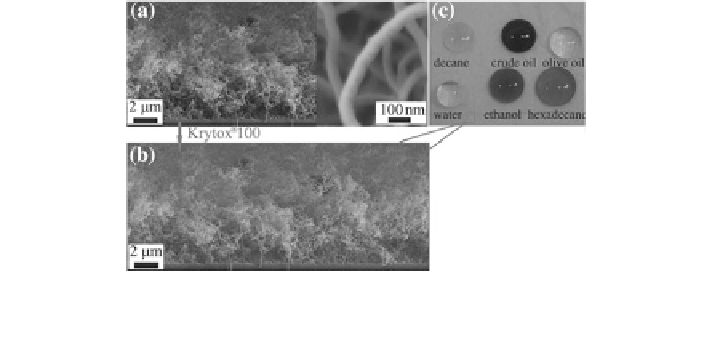Environmental Engineering Reference
In-Depth Information
Fig. 9.13
Preparation
of
the
composite
fluoro-silicone
nanofilaments/Krytox
anti-wetting
coatings
inspired
to
Nepenthes
pitcher,
and
various
liquids
contact
angle
(Adapted
with
permission from Zhang et al.
2013b
)
silicon wafer with superhydrophobic character and demonstrated the reduction of
contact time of water on the surface by breaking the drop dynamics symmetry.
This surface is now described as the most waterproof material ever. Investigations
from the same research group led in
2012
to LiquiGlide
TM
, a patented liquid-
impregnated, nontoxic coating based on SLIPS concept that has wide applications
in consumer packaged goods to decrease the adhesion of fluids—food, cosmetics,
drugs—to the container, thus improving product evacuation and reducing wastes
(Smith et al.
2013
).
Still, in the building industry—where large surface areas must be treated—the
most diffuse wetting modification treatments are those based on superhydrophobic
carbon nanotubes (CNTs) or SiO
2
(Guo and Wang
2010
; Bu and Oei
2010
) and
superhydrophilic TiO
2
(Chen and Poon
2009
; Diamanti and Pedeferri
2013
). As
for the latter case, several works describe the obtaining of self-cleaning, super-
hydrophilic glass, tiles and construction materials in general, with hundreds of
scientific publications and a growing number of self-cleaning products developed
and commercialized (Diamanti
2012
). Current evolutions in this research field are
related to combining micro and nanotextures with the photoinduced superhydro-
philicity of TiO
2
, as in the study proposed by Nakata et al. (
2011
), where PET
films with moth-eye-like surfaces were modified to achieve self-cleaning and
antireflective coatings for solar cells.
On the other hand, superhydrophobic treatments mainly involve glass and
textiles. Epoxy resin micropillars coated with 10 nm SiO
2
nanoparticles or mul-
tiwall CNTs showed excellent superhydrophobicity under 1 kPa water jet (contact
angles higher than 160, increasing hysteresis with exposure to water jet), com-
bined with mechanical stability and wear resistance (Jung and Bhushan
2009
;
Ebert and Bhushan
2009
).
Additionally, Joshi et al. (
2012
) proposed dip-coating and layer-by-layer self-
assembly of nanosilica and nanoclay particles to develop superhydrophobic cotton
through properly aligned
nanoroughness. Once again, matching an adequate

Search WWH ::

Custom Search